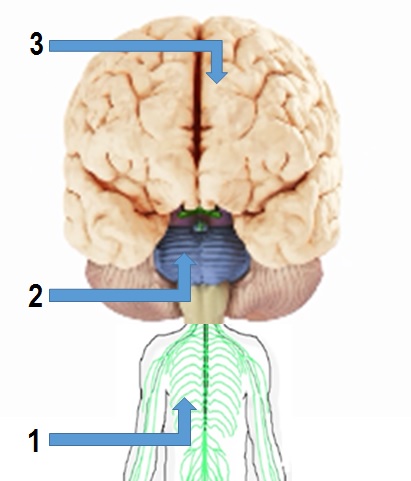Neurophysiology of Survival and Behaviour
|
The Figure shows physiological structure of how our bodies anatomically exercise control of human survival and behaviour. The control structure consists of three parts: (1) The nervous system, (2) Survival and emotion related limbic system, and (3) Thought related neocortex. the limbic system and the neocortex are parts of the brain. |
The nervous network is spread all over the body. It relays the internal local state of any part of the body to the brain. It also conveys signals of external perceptions by outer organs of cognition to the brain. In addition, it conveys to our inner organs the motor signals sent by our brain to respond to inner local states or through our muscles to outer motor organs to respond to external perceptions. The nervous network thus is responsible for input of information to the brain and output of commands from the brain. The brain controls our lives, both inner as well as outer.
Our outer life is our behavior in the external world in response to our external perceptions. Our inner life is whatever goes on internally in body or the mind. Our lungs are caused by our brains to inhale in response to the senses informing the brain of a shortage of oxygen, and exhale when our senses inform the brain of an excess of carbon dioxide. In addition to our lungs breathing, our hearts pump blood, our immune system protects us from harm by external organisms, our digestive system metabolizes food, our glands and liver secrete chemicals as per the demands of the time, hair and nails grow, and so on. There are thousands of signals flowing in the nervous system every second just to keep our body surviving in a sustainable manner. Many of these physiological processes run autonomously without our being aware of them while the others are volitional. Then there are mental processes running all the time except when we are in sound sleep. These mental processes determine the state of our mind: it may be anxious, excited, angry, stressed, calm, depressed, happy, sad, jealous, loving, hating and so on. Our mental states determine whether we behave thoughtfully in response to external perceptions or reactively. Reactive behaviour is almost autonomous without awareness.
The sensory signals flow from the body and the external cognitive organs to the brain through what may be described as sensory highways running in the spine. On top of the spine is a part of the brain called the limbic brain. This part of the brain is responsible for running body-mind processes which are either autonomic or almost autonomic (reactive). The limbic brain is located in such a way that it directly receives the sensory signals from the nervous system. Since bodily survival has an urgency to it and reactive external behaviour also has a degree of urgency to it, the limbic brain deals with them immediately without any input from the conscious neocortex which receives the sensory signals a touch later through the limbic brain. In most cases, the limbic brain acts on the sensory signal without the neocortex being aware of it at all (autonomic body processes and reactive external behaviour), In just a few cases, the neocortex becomes aware of the sensory input before the limbic brain has acted upon it; in those cases the response to sensory input may be thoughtful.
The limbic system is located physically in a position that it easily can hijack the thinking neocortex and run our lives without or only a little involvement of the neocortex. Training the neocortex to override the limbic brain in running the ordinarily autonomic breathing process in a regulated manner provides a strategy to involve the neocortex in running human lives with attention and thought.

